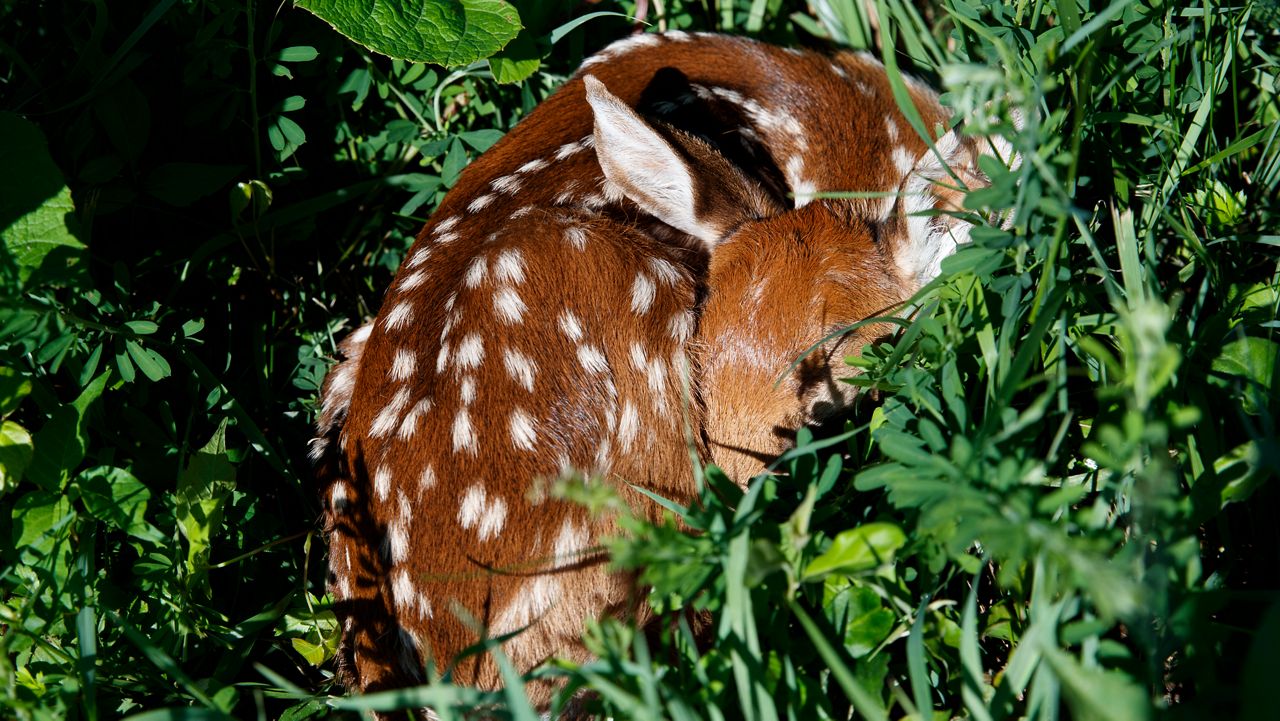RALEIGH, NC — As spring reaches its peak, wildlife officers are urging residents to withstand the urge to select up, transfer and even feed any child animals they might discover within the wild.
As folks enterprise out into the wild and even their dwelling gardens, some could come throughout younger rabbits, fawns, or younger birds mistakenly believed to be deserted. Whereas intuition could inform you to assist, officers say that most often, one or each mother and father will probably be a brief distance away, in search of meals and solely return as soon as you allow the world.
“Wild mother and father cannot rent a babysitter, so most younger animals spend a whole lot of time alone lengthy earlier than they’ll fend for themselves,” stated Falyn Owens, an extension biologist with the Wildlife Fee. “When the mom returns, typically many hours later, she expects to search out her younger the place she left them.”
Owens says the perfect factor to do most often is to go away the animal alone, return it, or name a wildlife rehabilitator as recommendation.
The next info offered by the North Carolina Wildlife Assets Fee can assist you assess the scenario and decide the perfect plan of action.
rabbits
New child rabbits (kits) spend their first few weeks hiding in plain sight, in shallow holes hidden in tufts of thick grass, beneath bushes, or in the midst of open lawns. Rabbit nests might be tough to identify, typically resembling a small patch of lifeless grass. Rabbits (or do) actively keep away from their nests, solely visiting them a few times a day for a couple of minutes, to keep away from attracting the eye of hungry predators.
“Each spring we hear from involved individuals who say they’ve discovered an deserted rabbit nest, when in actual fact the pups are high-quality and quietly ready for the doe to return,” Owens stated. “If they seem like wholesome and unhurt, the perfect factor to do is canopy the nest and stroll away. The mom won’t return till lengthy after you may have left the world.
fawns
New child deer additionally spend most of their time in hiding through the first few weeks of their lives. After nursing, the doe provides a sign and her fawns instinctively separate to discover a quiet place to lie down and be nonetheless. They are going to normally stay huddled collectively for a number of hours whereas the doe ventures out to feed. Fawns depend on a noticed coat and are scentless, making it tough for predators to search out them.
For those who discover a fawn that’s calm and seems unhurt, put it down and verify on it the following day. Whether it is nonetheless there and is bleating loudly, seems skinny, injured, or has seen diarrhea, contact a licensed fawn rehabilitator as recommendation.
“If a fawn has already been moved from the place it was discovered nevertheless it’s solely been a short time, return it instantly,” Owens stated. “A doe will normally attempt to discover her misplaced fawn for about 48 hours earlier than giving up. After 48 hours have handed, or the fawn has been given none meals, contact a fawn rehabilitator as quickly as attainable.”
songbirds
Understanding the distinction between a chick and a fledgling can assist you make the fitting resolution in the event you see a younger chicken on the bottom. The chicks don’t but have their feathers and can’t survive exterior their nest for lengthy. The chicks have their feathers and might stroll, leap or fly quick distances; they might seem helpless, however they’ve already left the nest and are being cared for by their mother and father, normally from a distance.
“For those who discover a chick on the bottom, get it again to the nest as rapidly as attainable, if yow will discover it,” Owens stated. “If the entire nest has fallen down, you may put it again within the tree and even construct a makeshift nest.”
The chicks, nonetheless, must be left alone most often. They’re busy with the vital duties of studying to fly and surviving on their very own. If a chick is not clearly injured or in quick hazard, go away it alone. Similar to human toddlers, younger birds want a whole lot of follow to realize the muscle groups and coordination to grow to be swish adults. Maintaining cats indoors and canines on leashes is one of the best ways to make sure these younger birds get via this susceptible studying stage.
obey the legislation
Leaving younger wildlife alone is just not solely a part of being a accountable steward of nature, it’s also the legislation.
“Eradicating most wild animals from the wild and placing them into your possession is unlawful,” Owens stated. “The probabilities of a younger wild animal surviving beneath human care are slim at greatest. Even those that stay lengthy sufficient to be freed won’t have developed the abilities to outlive on their very own.”
Owens additionally stresses the significance of by no means feeding younger wild animals, which may result in irreversible injury and is commonly deadly to the animal.
“If unsure, contact an expert earlier than doing so something”, she advises. “Every spring, wildlife rehabilitators see many malnourished, sick or injured youth from well-meaning folks attempting to supply care.”
And one final piece of recommendation: it’s best to go away the animal the place you discovered it, even when somebody has picked it up or touched it. Feral mother and father virtually by no means abandon their younger, even when they detect human scent.
